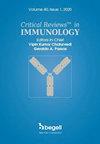丹参酮 IIA 在改善甲状腺切除术后甲状旁腺功能减退症方面的机理研究
IF 0.9
4区 医学
Q4 IMMUNOLOGY
引用次数: 0
摘要
背景:甲状腺切除术会导致甲状旁腺供血障碍,从而导致甲状旁腺功能减退。丹参酮 IIA(Tan IIA)有助于活血和保护心血管。因此,本研究探讨了丹参酮 IIA 对改善甲状旁腺功能减退症的疗效:方法:利用新西兰白兔建立单侧甲状旁腺缺血损伤模型。方法:利用新西兰白兔建立单侧甲状旁腺缺血损伤模型,选择性地结扎一侧甲状旁腺的主要供血血管,然后将兔子分为三组,分别服用1、5和10毫克/千克的Tan IIA。血清钙和甲状旁腺激素(PTH)水平是用专门的检测试剂盒测定的。免疫组化法用于评估甲状旁腺的微血管密度(MVD)。Western blotting(WB)用于分析与PI3K/AKT信号通路以及与该通路相关的HIF-1α和VEGF相关的蛋白质表达。此外,还通过 WB 检测了参与血管生成的 MMP-2 和 MMP-9:结果:坦 IIA 治疗可有效恢复血钙和 PTH 水平,且呈剂量依赖性。值得注意的是,甲状旁腺的 MVD 显著增加,尤其是在高剂量时。Tan IIA治疗还升高了p-PI3K/PI3K和p-AKT/AKT比率,表明PI3K/AKT通路被重新激活。此外,Tan IIA还能明显恢复甲状旁腺手术导致的血管内皮生长因子和HIF-1α表达水平的下降。此外,Tan IIA还能提高MMP-2和MMP-9的水平:Tan IIA可激活PI3K/AKT通路,通过调节VEGF、HIF-1α、MMP-2和MMP-9促进血管生成,从而进一步增强甲状旁腺内的MVD。本研究表明,丹参二酮能改善甲状腺切除术后的甲状旁腺功能减退症。本文章由计算机程序翻译,如有差异,请以英文原文为准。
Mechanistic Insights into Tanshinone IIA in the Amelioration of Post-Thyroidectomy Hypoparathyroidism
Background: Thyroidectomy causes impaired blood supply to the parathyroid glands, which leads to hypoparathyroidism. Tanshinone IIA (Tan IIA) is helpful in blood activation and cardiovascular protection. Therefore, the efficacy of Tan IIA in improving hypoparathyroidism was explored in this study.
Methods: New Zealand white rabbits were utilized to establish a unilateral parathyroid gland ischemia injury model. The model was created by selectively ligating the main blood supply vessel of one parathyroid gland, and the rabbits were then divided into three groups receiving 1, 5, and 10 mg/kg of Tan IIA. Serum calcium and parathyroid hormone (PTH) levels were measured using specialized assay kits. Immunohistochemistry was used to assess the microvessel density (MVD) in parathyroid glands. Western blotting (WB) was used to analyze protein expression related to the PI3K/AKT signaling pathway and the pathway-associated HIF-1α and VEGF. Moreover, MMP-2 and MMP-9 involved in angiogenesis were detected by WB.
Results: Tan IIA treatment effectively restored serum calcium and PTH levels in a dose-dependent manner. Notably, MVD in the parathyroid glands increased significantly, especially at higher doses. The Tan IIA treatment also elevated the p-PI3K/PI3K and p-AKT/AKT ratios, indicating that the PI3K/AKT pathway was reactivated. Moreover, Tan IIA significantly restored the decreased expression levels of VEGF and HIF-1α caused by parathyroid surgery. Additionally, Tan IIA increased MMP-2 and MMP-9 levels.
Conclusion: Tan IIA activates the PI3K/AKT pathway, promotes angiogenesis by modulating VEGF, HIF-1α, MMP-2, and MMP-9, thereby further enhancing MVD within the parathyroid glands. This study demonstrates that Tan IIA improved post-thyroidectomy hypoparathyroidism.
Methods: New Zealand white rabbits were utilized to establish a unilateral parathyroid gland ischemia injury model. The model was created by selectively ligating the main blood supply vessel of one parathyroid gland, and the rabbits were then divided into three groups receiving 1, 5, and 10 mg/kg of Tan IIA. Serum calcium and parathyroid hormone (PTH) levels were measured using specialized assay kits. Immunohistochemistry was used to assess the microvessel density (MVD) in parathyroid glands. Western blotting (WB) was used to analyze protein expression related to the PI3K/AKT signaling pathway and the pathway-associated HIF-1α and VEGF. Moreover, MMP-2 and MMP-9 involved in angiogenesis were detected by WB.
Results: Tan IIA treatment effectively restored serum calcium and PTH levels in a dose-dependent manner. Notably, MVD in the parathyroid glands increased significantly, especially at higher doses. The Tan IIA treatment also elevated the p-PI3K/PI3K and p-AKT/AKT ratios, indicating that the PI3K/AKT pathway was reactivated. Moreover, Tan IIA significantly restored the decreased expression levels of VEGF and HIF-1α caused by parathyroid surgery. Additionally, Tan IIA increased MMP-2 and MMP-9 levels.
Conclusion: Tan IIA activates the PI3K/AKT pathway, promotes angiogenesis by modulating VEGF, HIF-1α, MMP-2, and MMP-9, thereby further enhancing MVD within the parathyroid glands. This study demonstrates that Tan IIA improved post-thyroidectomy hypoparathyroidism.
求助全文
通过发布文献求助,成功后即可免费获取论文全文。
去求助
来源期刊
CiteScore
2.60
自引率
0.00%
发文量
14
审稿时长
>12 weeks
期刊介绍:
Immunology covers a broad spectrum of investigations at the genes, molecular, cellular, organ and system levels to reveal defense mechanisms against pathogens as well as protection against tumors and autoimmune diseases. The great advances in immunology in recent years make this field one of the most dynamic and rapidly growing in medical sciences. Critical ReviewsTM in Immunology (CRI) seeks to present a balanced overview of contemporary adaptive and innate immune responses related to autoimmunity, tumor, microbe, transplantation, neuroimmunology, immune regulation and immunotherapy from basic to translational aspects in health and disease. The articles that appear in CRI are mostly obtained by invitations to active investigators. But the journal will also consider proposals from the scientific community. Interested investigators should send their inquiries to the editor before submitting a manuscript.

 求助内容:
求助内容: 应助结果提醒方式:
应助结果提醒方式:


